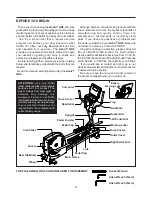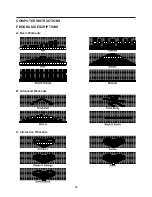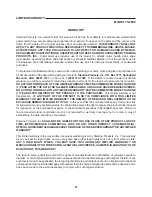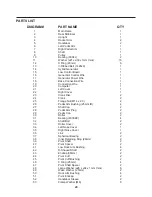
14
OPERATIONAL INSTRUCTIONS (continued)
HEART RATE MONITORING
To get the maximum benefit from your
Avari GX8
workout it is important that you exercise within your
target heart rate zone for at least 20 minutes. Research has shown that working out below your target heart
rate zone won
'
t burn fat or improve your cardiovascular fitness, and working above your target heart rate
zone is also counter productive.
Everyone has their own target heart rate zone and exercising within that zone should be your goal every
time you work out. Finding your personal target heart rate zone is calculated by:
The
Avari GX8
can measure how hard you are exercising in two ways:
PULSE MONITOR V. HEART RATE TRANSMITTER
Load Level Adjustment
The load level of
Avari GX8
can be changed at any time during your workout. Adjusting the load level will
allow you to increase or decrease your intensity level.
Forward and Reverse
The
Avari GX8
can be used in the forward and reverse direction to vary the muscles that you work out.
This will also vary your workout helping you to stay motivated. To change directions, simply slow the pedals
down until they stop and switch directions.
Find your maximum heart rate with this simple formula:
220 - Age = predicted maximum heart rate
Example: A 40-year-old would have a predicted maximum heart rate of
180 beats per minute, 220 - 40 = 180.
Your target heart rate zone is a range that is 55% to 90% of your
maximum heart rate.
*
Predicted Maximum Heart Rate x .55 = lower end of target heart rate zone
Predicted Maximum Heart Rate x .90 = upper end of target heart rate zone
Example: A 40-year-old would have a Target Heart Rate Zone of 99 to
162 beats per minute; 180 x .55 = 99. 180 x .90 = 162.
See page 24 of this Owner
'
s Manual for more conditioning guidelines including a chart of target
Heart Rate Zones Estimated by Age.
* For cardiorespiratory training benefits, the American College of Sports Medicine recommends
working out within a heart rate range of 55% to 90% of maximum heart rate.
STEP 1:
STEP 2:
NOTE:
1. By measuring your pulse
2. By monitoring your heart rate
Your pulse is monitored by four Pulse Sensors that are built into both the left and right Hand Grips, two in
each grip. Your pulse reading gives you a snapshot of how hard your heart is working at that point in your
workout by measuring the number of heart beats per minute. Please note that pulse sensors provide less
accurate information than the heart rate transmitter and pulse sensors don
'
t monitor your heart rate during
your entire workout; the heart rate transmitter does monitor your heart rate for the endurance of your
workout.





























